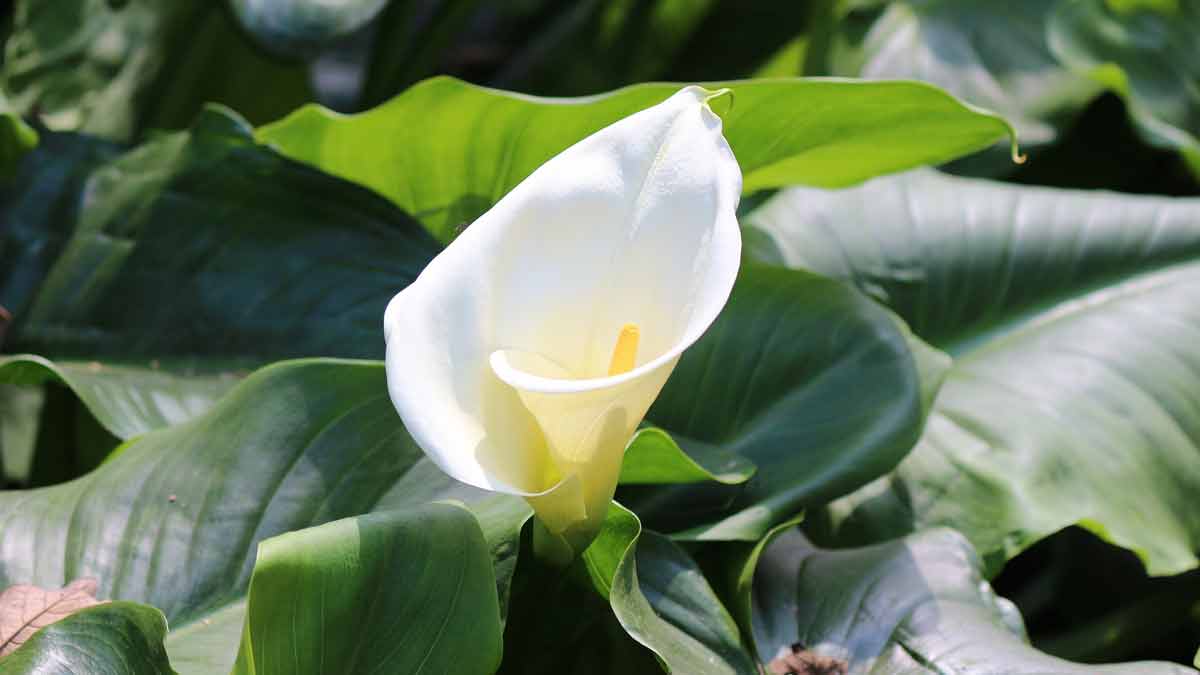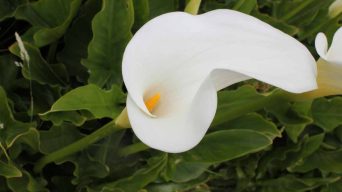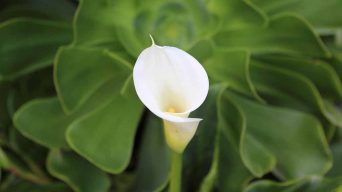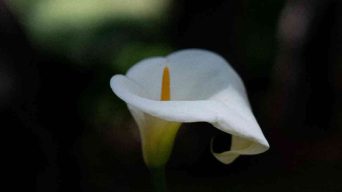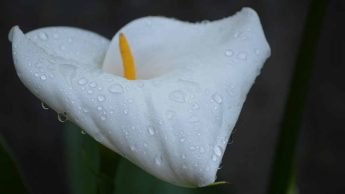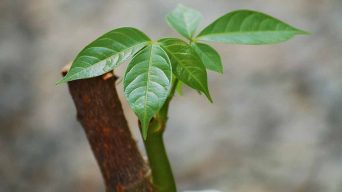Brown tips on calla lilies can indicate overwatering or sun damage. The leaves may also turn brown due to pests, lack of nutrition, drought stress, or diseases. Adjust watering, lighting, and temperature conditions to revive a dying Calla Lily.
Calla Lilies, prized for their elegant and distinctive appearance, are a favorite among plant enthusiasts.
However, seeing your Calla Lily leaves turning brown can be disheartening as you wonder what might be causing this issue.
Brown leaves on your Calla Lily can stem from various factors, including environmental conditions and pest infestations.
Here we’ll delve deep into the causes of browning leaves in Calla Lilies and provide solutions to fix them so that you can rejuvenate your beloved plant.
Causes Of Brown Leaves In Calla Lilies
Calla Lily leaves turning brown can be caused by a range of factors.
Environmental stressors, such as too much sunlight or incorrect watering, cold temperatures, dry air, pest infestations or fungal diseases, and nutrient deficiencies, can all contribute to the issue.
Understanding the underlying causes can help prevent and treat brown leaves in Calla Lilies.
Environmental Factors
Environmental factors play a significant role in the health and appearance of your Calla Lilies, with many issues that can lead to brown leaves being directly related to their growing conditions.
For instance, Calla Lilies thrive in bright but indirect sunlight.
Placement in direct sunlight can cause sunburn, leading to unsightly brown patches or crisp leaf tips.
Overwatering or underwatering your plant may also contribute to the problem of browning leaves.
When Calla Lilies receive too much water, they become susceptible to root rot, negatively affecting their ability to take up nutrients and oxygen adequately.
This will eventually manifest as yellowing leaves that turn brown and die off.
Exposure To Direct Sunlight
Exposure to direct sunlight is a common cause of Calla Lily leaves turning brown.
While these beautiful plants enjoy bright, indirect light, they can suffer from sunburn when placed in areas with harsh, direct rays.
The delicate foliage of the Calla Lily plant becomes stressed and damaged, resulting in curling leaves as it tries to withstand the intense heat and radiation that comes from unfiltered sunlight.
If you suspect that your Calla Lily’s leaf browning issue stems from excessive exposure to sunlight, there’s an easy fix: simply relocate your plant to a more shaded area or protect against intense UV rays.
For instance, moving the plant near windows with filtered light can offer just enough brightness without causing harm.
Another solution is using shade cloth during peak sun hours for outdoor plants susceptible to sunburns.
Overwatering Or Underwatering
An improper watering schedule is one common reason Calla Lily leaves turn brown.
Overwatering your Calla Lilies can lead to root rot. In this condition, the roots begin to decay due to excessive moisture in the soil.
This disrupts the plant’s ability to absorb nutrients and causes a lack of oxygen, eventually browning leaves.
To prevent over- and under-watering issues with your Calla Lily plants, it’s crucial to strike a balance when maintaining soil moisture.
A good rule of thumb is watering Calla lilies once a week or when you feel that the top inch of soil has dried out since last watered – this will ensure optimal hydration without drowning their delicate root system.
Cold Temperatures
Cold temperatures can be a significant factor in causing brown leaves in Calla Lilies.
These plants are sensitive to cold weather, and exposure to low temperatures can cause their leaves to turn brown and eventually die.
Additionally, if your plant is grown indoors and located near windows or drafty areas, ensure the temperature stays above 60 degrees Fahrenheit.
Keeping the plant away from cold drafts will also prevent fluctuations in temperature that may damage its delicate foliage.
Dry Air
Dry air is a common cause of brown leaves in Calla Lilies.
When the air around the plant is too dry, it can cause the moisture to evaporate quickly from the leaves, making them brittle and prone to turning brown.
To remedy this issue, plant enthusiasts should consider increasing the humidity level around their plants by using a humidifier or misting them regularly with water.
It’s also important to note that combined with high temperatures indoors during summer when people typically run their ACs more often than not, dry air does even more harm to Calla Lilies.
Pests And Diseases
Pests and diseases are common culprits of brown leaves in Calla Lilies.
Several pests can affect calla lilies, including spider mites and thrips.
Spider mites are tiny insects that suck the sap out of leaves, causing them to turn grayish-white or yellow before finally turning brown and dropping off.
Fungal diseases can also lead to brown spots on Calla Lily leaves.
Botrytis blight is a common fungal disease that affects many different types of plants, including calla lilies.
It causes dark, water-soaked lesions on the foliage and flowers, eventually turning tan or gray with fuzzy growth on top.
To prevent pest infestations and fungal diseases from damaging your Calla Lily leaves, it’s important to practice proper plant care techniques.
Nutrient Deficiencies
Nutrient deficiencies are a common cause of brown leaves in Calla Lilies.
This can occur when the plant doesn’t receive enough essential nutrients such as nitrogen, phosphorus, or potassium.
One example is that too much nitrogen can lead to excessive foliage growth but prevent blooming, resulting in brown edges on the leaves.
To avoid this issue, it’s important to use a balanced fertilizer and follow recommended usage instructions carefully.
Solutions To Brown Leaves In Calla Lilies
If you are experiencing brown leaves on your Calla Lilies, there are several solutions to the problem.
To remedy the issue, take action by adjusting the watering schedule, providing proper nutrients, and increasing humidity levels.
Additionally, it’s important to control pests and diseases promptly, prune damaged leaves and stems, and keep the plant away from drafts.
By taking these steps, you can help restore the health and beauty of your calla lilies.
Environmental Solutions
To combat brown Calla Lily leaves caused by environmental factors, there are several solutions you can try.
One of the most common reasons for leaf browning is exposure to direct sunlight.
Moving the plant to a shaded area indoors or outdoors can help alleviate this issue.
Another factor that may cause browning is dry air, which commonly affects plants grown indoors during cold weather months.
To increase humidity around the plant, try using a room humidifier or placing it on top of a tray filled with wet pebbles.
Keeping your Calla Lily away from drafts will also prevent wilting and yellowed leaves caused by temperature fluctuations.
Adjusting The Watering Schedule
Adjusting the watering schedule is crucial to fixing brown leaves in Calla Lilies.
Follow these steps to help prevent over or under-watering:
- Water the plant thoroughly, allowing excess water to drain from the pot’s bottom.
- Check the plant’s soil moisture level regularly by sticking your finger an inch deep into the soil.
- Avoid watering until the top inch of the soil is dry to the touch.
- Adjust your watering frequency based on environmental factors such as temperature, humidity, and sunlight intensity.
- Use well-draining potting mix and containers with drainage holes to ensure proper water drainage.
Moving The Plant To A Shaded Area
If you notice that the leaves of your Calla Lily plant are turning brown, moving it to a shaded spot might be the solution.
Direct sunlight can cause excessive heat and water loss in delicate plants like Calla Lilies, leading to dry and crispy leaves.
It’s also essential to note that different varieties of Calla Lilies have diverse shade preferences.
For instance, while Zantedeschia aethiopica thrives best in full sun or partial shade, other species prefer more shade than sun.
Hence, research your specific variety and experiment with various locations until you find one that works for them.
Increasing Humidity
One solution to brown Calla Lily leaves is to increase the humidity around the plant.
These plants thrive in moist soil and can suffer if the air around them is too dry.
You can raise humidity levels by placing a tray of water near the plant or using a humidifier in the room where it’s located.
It’s important to note that different species of Calla Lilies have varying preferences regarding humidity levels, so be sure to research your specific plant’s needs before making any changes.
Keeping The Plant Away From Drafts
Drafts are a common cause of stress for Calla Lily plants, which can result in excessive leaf yellowing and browning.
Drafts can come from open doors, windows, vents, or air conditioning units that create inconsistent temperature zones around the plant.
To prevent drafts from reaching your Calla Lily plant, you should choose an area to place it where there is no exposure to direct air flow.
You can also use physical barriers like curtains, window insulation film, or custom-fitted draft blockers under doors or windows to prevent air flow from disrupting the growth environment of your plant.
Remember that even a small amount of breeze could affect larger leaves on this type of plant which are more susceptible to movement than others.
Pest And Disease Control
To control pests and diseases in Calla Lilies, it is important to practice cultural control measures such as keeping the plant dry and free from debris.
Here are some additional pest and disease control solutions for brown leaves in Calla Lilies:
- Neem oil: This natural insecticide can help repel pests like mealybugs, spider mites, and aphids.
- Soap spray: A dish soap and water solution can be sprayed onto foliage to kill soft-bodied insects like spider mites and whiteflies.
- Fungicides: For fungal diseases like powdery mildew or leaf spot, organic fungicides like copper-based sprays or baking soda solutions can be used to prevent the further spread of the disease.
- Bactericides: Bacterial soft rot can be controlled by cutting off infected parts of the plant, reducing the watering frequency, and applying bactericides like copper solutions or hydrogen peroxide.
Nutrient Solutions
If your Calla Lily leaves are turning brown due to nutrient deficiencies, addressing this issue is critical to nursing your plant back to health.
Fertilization can help provide the necessary nutrients for healthy growth and prevent further browning of leaves.
A balanced fertilizer with equal parts of nitrogen, phosphorus, and potassium can support robust foliage development in Calla Lilies.
It’s important to note that over-fertilizing can do more harm than good by causing leaf burn or even plant death.
To avoid this, it’s best to follow the fertilizer instructions on product packaging or use slow-release fertilizers that gradually release nutrients over time.
Pruning And Trimming Damaged Leaves And Stems
If your Calla Lily leaves have turned brown, acting quickly to prevent the issue from worsening is essential.
Pruning and trimming damaged leaves and stems can be an effective way to stop the spread of the problem.
Here are some tips on how to do it:
- Use clean, sharp scissors or pruning shears to cut off any brown or yellowed leaves at the base of the stem. Be sure to avoid damaging any healthy foliage while doing this.
- If you notice any soft or mushy stems, use a sterile cutting tool to remove these as well. Soft rot is a common issue affecting Calla Lilies and other plants if they’re overwatered or exposed to high humidity.
- Once you’ve removed all the damaged foliage, dispose of it properly. Do not compost it or leave it on the soil surface where fungal spores could spread.
- To help prevent further damage in the future, make sure your plant is getting enough water but not too much, and avoid exposing it to extreme temperatures or direct sunlight for long periods.
Preventing Brown Leaves In Calla Lilies
To keep your Calla Lilies healthy and vibrant, taking a few preventative measures can go a long way in preventing brown leaves.
This can be achieved through proper watering, adequate sunlight and temperature, regular fertilization, and pest and disease management.
Early detection and treatment of problems are also crucial to maintaining the plant’s health.
Proper Watering And Drainage
Proper watering and drainage are crucial factors in keeping Calla Lilies healthy and preventing brown leaves.
Here are some tips to ensure your plants receive adequate water and drainage:
- Watering: Keep the soil moist but not waterlogged. This can be achieved by watering the plant thoroughly once a week, then waiting until the top inch of soil is dry before watering again. Avoid letting the soil dry out completely or sitting in standing water, as this can cause root rot.
- Drainage: Good drainage is essential for calla lilies as they do not tolerate wet feet well. Use well-draining soil with peat moss or perlite to ensure proper aeration and drainage. Make sure pots have drainage holes or use a layer of gravel at the bottom to allow excess water to drain away from the roots.
- Monitoring: Regularly check the soil moisture level by sticking your finger about an inch into it – if it feels dry, it’s time to water. Also, watch any signs of overwatering or underwatering, such as yellowing leaves or stunted growth.
Adequate Sunlight And Temperature
Proper exposure to sunlight and temperature is crucial in ensuring that your Calla Lilies remain healthy and avoid brown leaves. These plants thrive well when placed in a bright location with indirect sunlight.
Calla Lilies also require moderate temperatures to grow satisfactorily. Keep them away from places with drafts, such as entryways or air vents, which can cause sudden changes in their environment and result in brown leaves.
By maintaining adequate sunlight levels and stable temperatures for your Calla Lilies, you’ll keep your plant’s foliage vibrant green without turning brown prematurely.
Regular Fertilization
Proper fertilization is crucial in preventing brown leaves in calla lilies. Here are some points to keep in mind:
- Fertilize calla lilies every two weeks during the growing season to promote healthy foliage and blooms.
- Use a balanced fertilizer with equal amounts of nitrogen, phosphorus, and potassium.
- Avoid over-fertilizing, as this can cause salt buildup in the soil, leading to brown leaves.
- If using a slow-release fertilizer, follow the manufacturer’s instructions for application rates and frequency.
- Monitor your plant’s growth carefully and adjust your fertilization schedule accordingly.
Pest And Disease Prevention Through Proper Plant Care
To prevent pests and diseases that can cause brown leaves in Calla Lilies, it’s important to practice proper plant care.
Here are some tips:
- Keep your plant clean: Regularly wipe down the leaves with a damp cloth to remove dust and debris that can harbor pests and diseases.
- Avoid overcrowding: Crowded plants are more susceptible to pest infestations and fungal growth. Make sure your Calla Lily has enough space to grow.
- Use quality soil: Choose a well-draining potting mix to avoid waterlogging, which can lead to root rot and other issues.
- Water properly: Overwatering can suffocate the roots, leading to disease, while underwatering can stress the plant and make it more vulnerable to pests. Water your Calla Lily only when the top inch of soil is dry.
- Fertilize regularly: A healthy plant is less likely to fall victim to pests and diseases. Feed your Calla Lily with a balanced fertilizer every two weeks during the growing season.
By following these simple steps, you can help prevent brown leaves in Calla Lilies caused by pest infestations, fungal growth, or other issues related to poor plant care.
Early Detection And Treatment Of Issues
Early detection and treatment of issues are crucial in preventing brown leaves in Calla Lilies.
By regularly inspecting your plants for any signs of pests or diseases, you can address the problem before it becomes severe.
One effective way to treat bacterial soft rot is by cutting off the diseased parts and applying a fungicide.
For the browning of leaves caused by nutrient deficiencies, adding a well-balanced fertilizer to the soil can help improve plant health.
Final Thoughts
Brown leaves on your Calla Lilies can indicate various issues that must be addressed promptly.
Environmental factors like too much sunlight, improper watering, and pests and diseases can cause this problem.
However, fear not!
With proper care and attention, you can easily fix this issue by adjusting the water schedule or moving the plant to a shaded area.
By providing adequate nutrients and keeping an eye out for any signs of stress or disease early on, you can prevent further damage to your precious calla lilies.

